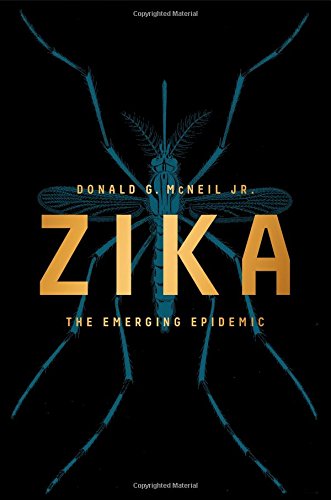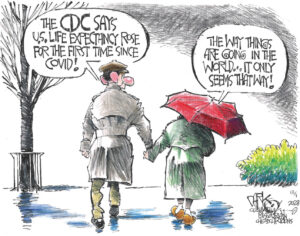Zika: The Emerging Epidemic
The spread of the Zika virus is a public health story, but politics isn't far behind. The consuming controversy here is why the Centers for Disease Control and Prevention and the World Health Organization have dragged their feet in strongly recommending that women delay pregnancy. W. W. Norton & Company
W. W. Norton & Company
W. W. Norton & Company
| To see long excerpts from “Zika” at Google Books, click here. To read a newly published article in the Miami Herald about the first local transmission of the Zika virus in the United States, click here. |
“Zika: The Emerging Epidemic” A book by Donald G. McNeil Jr.
Donald G. McNeil Jr. believes the Centers for Disease Control and Prevention is doing a disservice to women exposed to the Zika virus. Here’s McNeil, The New York Times’ global health correspondent, venting his frustration in an interview for his new book, “Zika.”
Discussing the epidemic with Denise Jamieson, team leader of the CDC’s women’s health and fertility branch, who advises CDC Director Tom Frieden, McNeil points out the obvious: that avoiding pregnancy in Zika areas is the only certain way to prevent having a baby with the tiny head and deformed brain characteristic of Zika-induced microcephaly.
“Why,” he asks, “would the CDC not advise women to wait?”
“I think the government getting involved in highly personal decisions about when to have a baby is not likely to be very effective,” Jamieson explained.
“Suppose you were in your job in 1964,” McNeil said, “and you knew that huge rubella outbreak was starting. There was no vaccine. You knew the consequences. Babies would suffer. What would your advice have been then?”
“I’d say,” Jamieson answered, “‘This is an extraordinarily risky time to get pregnant.’ ”
“But you won’t give the same advice now?”
“This is different,” she said. “There was no vaccine then. Highly motivated women can avoid mosquito bites.”
“For nine months, 24 hours a day?” McNeil asked. “Is that realistic?”
The spread of Zika is a public health story, but, as is often the case with pandemics, politics is never far behind. The consuming controversy in the case of Zika is why the CDC and the World Health Organization have dragged their feet in giving strong recommendations to women to delay pregnancy. Some Latin American countries, including Brazil, have asked women to do so. In June, after McNeil’s book went to press, the WHO issued an advisory asking women to consider delaying pregnancy. However, the CDC has yet to send out similar advice. Instead, it warns women to avoid mosquito bites and not travel to areas of the globe such as South America, Central America, the Caribbean and the Pacific Islands, where Zika is a risk.
McNeil’s account of the rise and spread of Zika is tight and highly informative. We learn that in August 2015, babies with the small heads and deformed brains indicative of microcephaly began appearing in maternity wards in the northeastern tip of Brazil. The condition became popularly known as doenca misteriosa, Portuguese for “mystery disease.” A few months later, a local public health agency identified it as an African virus first discovered in 1947 in a monkey in the Zika forest in Uganda.
When the Brazilian health minister learned this, the connection between the virus and microcephaly was not yet established, and his reaction was relief. “Zika doesn’t worry us. It’s a benign disease,” he said. Indeed, the result of being bitten by a Zika-carrying mosquito had typically been a mild affair: a rash, fever and headache in the vast majority of people. Some infected individuals experienced no symptoms at all. Compared with the ravages of other diseases common in South America — such as malaria, dengue, yellow fever and chikungunya, which are carried by the same species of mosquito, Aedes aegypti — there was little reason to panic.
McNeil’s early pages conjure the kind of eerie calm that comes before doom. Zika, as the world has come to learn, is not your run-of-the-mill “bug.” According to the WHO, it is now a public health emergency, with the potential to leave massive damage and heartbreak in its wake — and disrupt this year’s Summer Olympics in Rio.
“Never before in history has there been a situation where a bite from a mosquito can result in a devastating malformation” of offspring, said the CDC’s Frieden. This dread distinction is due to Zika’s ability, unique for a mosquito-borne virus, to routinely cross the placenta; it is also the only mosquito-borne virus that is sexually transmitted.
Though 80 to 90 percent of cases are thankfully mild, 1 to 13 percent of infected pregnant women will have microcephalic babies. Such children may be blind or deaf. Some may never learn to stand, walk or control their bowels. Serious learning disabilities persist from childhood on. In adults, the Zika virus can trigger the rare but debilitating Guillain-Barre syndrome, an autoimmune condition in which paralysis sets in. The condition is usually temporary, but if it affects the diaphragmatic muscles, the patient must receive life support to enable breathing.
The story of Zika, like many biographies of pandemics, remains a mystery narrative, even after the pathogen has been identified as the culprit. How exactly does Zika affect neural tissue? How does it cross the placenta? How soon after infection will damage to the fetus appear? What if a baby is infected at birth? Can a man transmit it without ever having symptoms? Can a woman transmit it sexually?
McNeil has covered other diseases of the world’s poor, including AIDS, malaria, avian flu, SARS, mad cow disease and other “plagues and pestilences,” as his author page puts it. Most eye-catching, the first case of microcephaly in the United States and its territories was recorded in Puerto Rico in May 2016 (the first Zika death was also there, in February). Now Zika is spreading across the Caribbean island. Further, a woman who had earlier lived in Brazil gave birth to a deformed baby in Hawaii, as did a Honduran woman visiting New Jersey. Both tragedies were caused by Zika.The long, hot summer is now upon us, and the expectation is that local transmission will happen in the United States. The best hope is a vaccine, but that will probably take at least two years to develop. In June, the Food and Drug Administration approved a clinical trial for an experimental Zika vaccine.
Right now, at least 298 million people in the Americas live in areas conducive to Zika transmission. Impoverished, overcrowded areas and the Gulf Coast region are particularly at risk. Messages from some public health officials — “a whole generation of neuro-devastated children,” warned one — may be too alarmist. Still, McNeil adopts a cautious stance and strongly recommends that women delay conception, even though the CDC hesitates to take this step.
The CDC’s view is not unique, however. An Amnesty International activist told McNeil that government advice to delay pregnancy puts “women in an impossible position by asking them to put the sole responsibility for public health on their shoulders by not getting pregnant when over half don’t have that choice.” A spokeswoman for the Center for Reproductive Rights in New York called the advice “naive” and “irresponsible,” noting that governments “were not issuing any recommendation for the men to use condoms, which is very unfair.”
McNeil closes the book with a useful appendix detailing responses to most-asked questions. The one he cannot answer, of course, is: How much harm will Zika wreak in our country and the world?
Sally Satel is a psychiatrist and a resident scholar at the American Enterprise Institute. She is a co-author of “Brainwashed: The Seductive Appeal of Mindless Neuroscience.”
©2016, Washington Post Book World Service/Washington Post Writers Group
Your support matters…Independent journalism is under threat and overshadowed by heavily funded mainstream media.
You can help level the playing field. Become a member.
Your tax-deductible contribution keeps us digging beneath the headlines to give you thought-provoking, investigative reporting and analysis that unearths what's really happening- without compromise.
Give today to support our courageous, independent journalists.







You need to be a supporter to comment.
There are currently no responses to this article.
Be the first to respond.